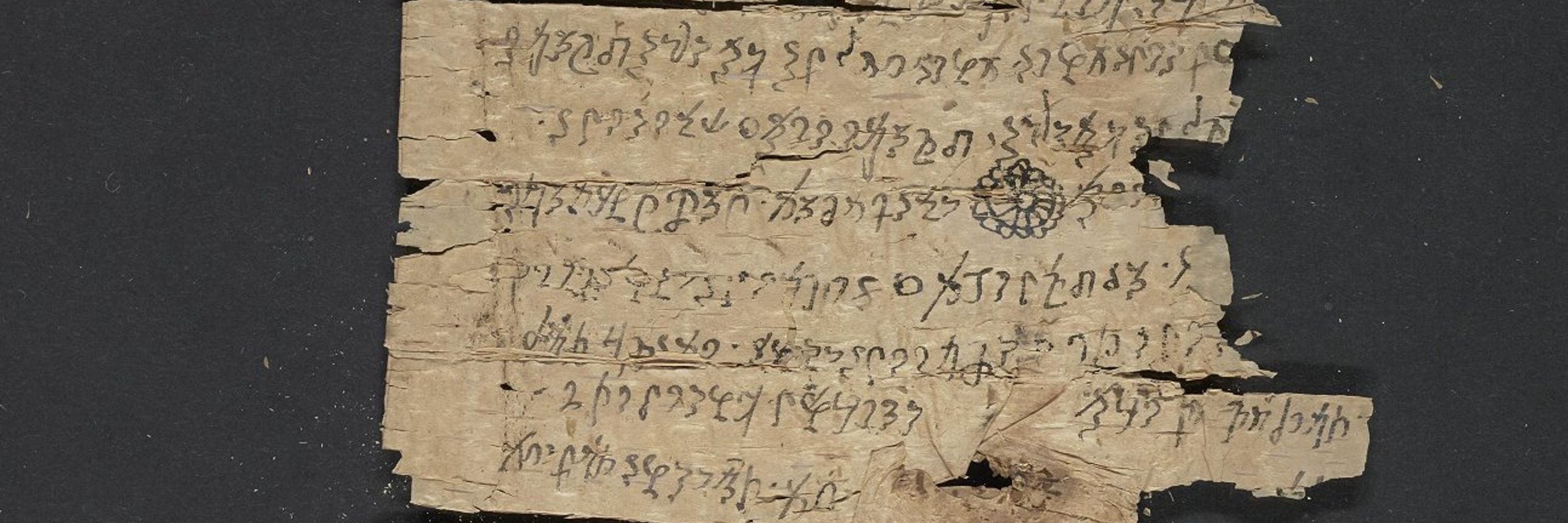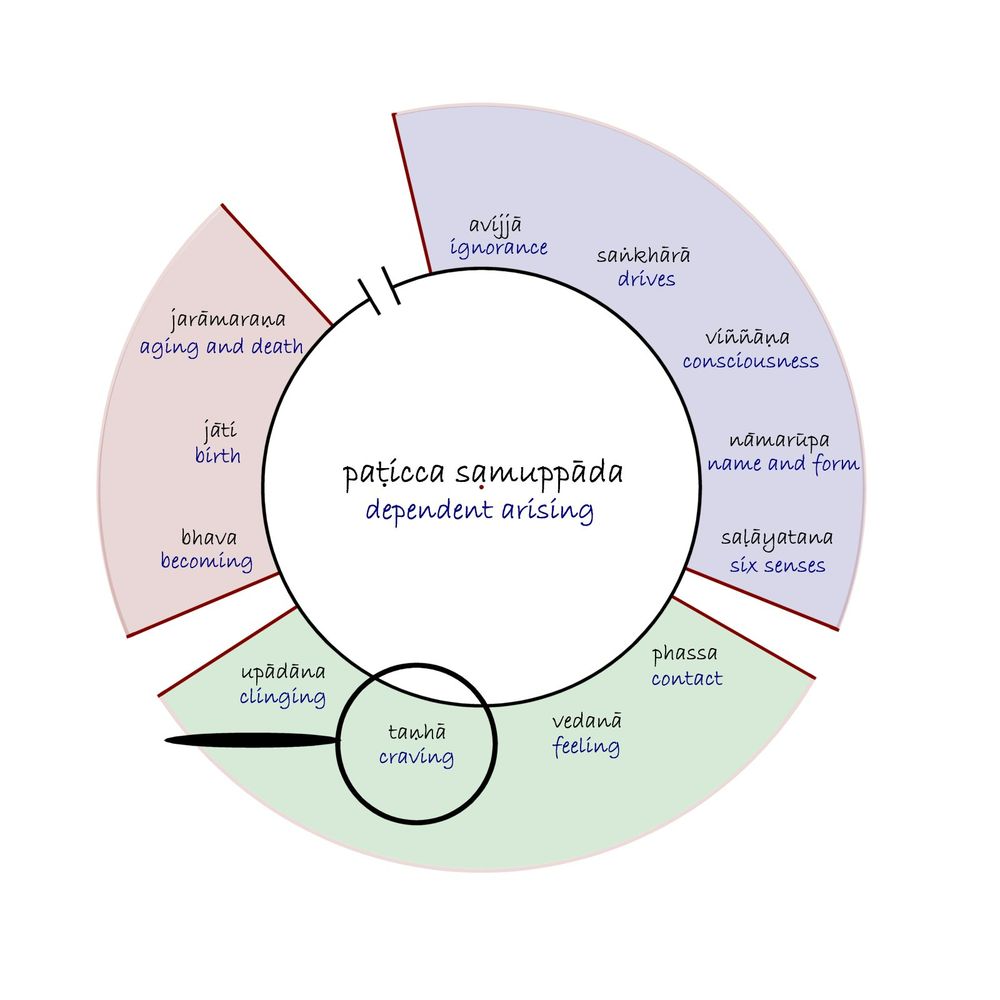

![quote from MN 9 translated by Bhikkhu Bodhi
At the top, the Pali language that was translated. Below, Bodhi's translation. The words being translated each have their own background color, which is matched to those words' translations.
“And what, bhikkhus, is birth? The birth of various beings into the various orders of beings, being born, descent [into the womb], production, the manifestation of the aggregates, the obtaining of the sense bases. This is called birth."](https://cdn.bsky.app/img/feed_thumbnail/plain/did:plc:rwy7gautkkjh2u36ludhjfjm/bafkreifsmor5swv7epftvq7drfppktom5e5thovxtvc2a5e7uz7jllensi@jpeg)
![quote from SN 12.2 translated by Bhikkhu Bodhi
“And what, bhikkhus, is birth? The birth of the various beings into the various orders of beings, their being born, descent [into the womb], production, the manifestation of the aggregates, the obtaining of the sense bases. This is called birth."](https://cdn.bsky.app/img/feed_thumbnail/plain/did:plc:rwy7gautkkjh2u36ludhjfjm/bafkreigconxijpthc42xawtohlamvtvxuyux7qrlcxlkllomhus3oho5ce@jpeg)
![opening quote from sutta
"Quarrels and Disputes"
Sn 4.11 [pts Sn 862]
translated by Thanissaro Bhikkhu
"From where have there arisen
quarrels, disputes,
lamentation, sorrows, along with selfishness,
conceit & pride, along with divisiveness?
From where have they arisen?
Please tell me."
"From what is dear
there have arisen
quarrels, disputes,
lamentation, sorrows, along with selfishness,
conceit & pride, along with divisiveness.
Tied up with selfishness
are quarrels & disputes.
In the arising of disputes
is divisiveness."](https://cdn.bsky.app/img/feed_thumbnail/plain/did:plc:rwy7gautkkjh2u36ludhjfjm/bafkreifqjz2v6z4nuaejhhojaulevrgc7ztuphr2kaujej3dchp7pjd7ry@jpeg)

![excerpt from AN 3.76 [pts A i 223] translated by Bhikkhu Bodhi
“Bhante, it is said: ‘existence, existence.’ In what way, Bhante, is there existence?”
(1) “If, Ānanda, there were no kamma ripening in the sensory realm, would sense-sphere existence be discerned?”
“No, Bhante.”
“Thus, Ānanda, for beings hindered by ignorance and fettered by craving, kamma is the field, consciousness the seed, and craving the moisture for their consciousness to be established in an inferior realm. In this way there is the production of renewed existence in the future."](https://cdn.bsky.app/img/feed_thumbnail/plain/did:plc:rwy7gautkkjh2u36ludhjfjm/bafkreieank6uuli67yr4ekkagcpuyqxwun5wsxpf5d7v4aeczldisx3pom@jpeg)
#SB40of10k

#SB40of10k

![MN 11 [pts M i 65] translated by Bhikkhus Nanamoli and Bodhi. Within the text an arrow points from the number "170" at the end of paragraph 6 to the footnote numbered 170.
Paragraph 6.
“Bhikkhus, there are these two views: the view of being and the view of non-being. Any recluses or brahmins who rely on the view of being, adopt the view of being, accept the view of being, are opposed to the view of non-being. Any recluses or brahmins who rely on the view of non-being, adopt the view of non-being, accept the view of non-being, are opposed to the view of being.170
Footnote 170
The view of being (bhavadiṭṭ) is eternalism, the belief in an eternal self; the view of non-being (vibhavadiṭṭhi) is annihilationism, the denial of any principle of continuity as a basis for rebirth and kammic retribution. The adoption of one view entailing opposition to the other ties up with the earlier statement that the goal is for one who does not favour and oppose.](https://cdn.bsky.app/img/feed_thumbnail/plain/did:plc:rwy7gautkkjh2u36ludhjfjm/bafkreih4qwjve6jxohmuaumjj5cvss62tgapl6tizgcqutezhxkz42vjgm@jpeg)

![Excerpts from MN 11 [pts M i 66] translated by Bhikkhus Bodhi and Nanamoli
9. “Bhikkhus, there are these four kinds of clinging. What four? Clinging to sensual pleasures, clinging to views, clinging to rules and observances, and clinging to a doctrine of self.
10. “Though certain recluses and brahmins claim to propound the full understanding of all kinds of clinging, they do not completely describe the full understanding of all kinds of clinging. They describe the full understanding of clinging to sensual pleasures without describing the full understanding of clinging to views, clinging to rules and observances, and clinging to a doctrine of self. Why is that? Those good recluses and brahmins do not understand these three instances of clinging as they actually are. Therefore, though they claim to propound the full understanding of all kinds of clinging, they describe only the full understanding of clinging to sensual pleasures without describing the full understanding of clinging to views, clinging to rules and observances, and clinging to a doctrine of self.
(ellipse indicating some repetitive variations are left out)
12. “Though certain recluses and brahmins claim to propound the full understanding of all kinds of clinging…they describe the full understanding of clinging to sensual pleasures, clinging to views, and clinging to rules and observances without describing the full understanding of clinging to a doctrine of self... 173
(Footnote follows)
173 This passage clearly states that the critical factor differentiating the Buddha’s teaching from all other religious and philosophical creeds is its “full understanding of clinging to a doctrine of self.” This means, in effect, that the Buddha alone is able to show how to overcome all views of self by developing penetration of the truth of non-self. Since the other spiritual teachers lack this understanding of non-self, their claims to fully understand the three other kinds of clinging are also suspect.](https://cdn.bsky.app/img/feed_thumbnail/plain/did:plc:rwy7gautkkjh2u36ludhjfjm/bafkreif7paioaucgimq3ef5j2mea7dnpew2jcqjggg43zxybpzp7eavsga@jpeg)
![Excerpts from SN 22.83 [pts S iii 105] translated by Thanissaro Bhikkhu
"'It's with possessiveness, friend Ananda, that there is "I am," not without possessiveness. And through possessiveness of what is there "I am," not without possessiveness? Through possessiveness of form there is "I am," not without possessiveness. Through possessiveness of feeling... perception... fabrications... Through possessiveness of consciousness there is "I am," not without possessiveness.
"'Just as if a young woman — or a man — youthful, fond of adornment, contemplating the image of her face in a mirror, pure & bright, or in a bowl of clear water, would look with possessiveness, not without possessiveness. In the same way, through possessiveness of form there is "I am," not without possessiveness. Through possessiveness of feeling... perception... fabrications... Through possessiveness of consciousness there is "I am," not without possessiveness.
https://www.accesstoinsight.org/tipitaka/sn/sn22/sn22.083.than.html](https://cdn.bsky.app/img/feed_thumbnail/plain/did:plc:rwy7gautkkjh2u36ludhjfjm/bafkreidhbzwzyfs2sghsqfcppdxgh4peobdd4qe6dvr4gnosn4imtad6im@jpeg)

![Excerpt from a translation of MN 72 by Thanissaro Bhikkhu. [pts M i 487]
"Of course you're befuddled, Vaccha. Of course you're confused. Deep, Vaccha, is this phenomenon, hard to see, hard to realize, tranquil, refined, beyond the scope of conjecture, subtle, to-be-experienced by the wise. For those with other views, other practices, other satisfactions, other aims, other teachers, it is difficult to know. That being the case, I will now put some questions to you. Answer as you see fit. What do you think, Vaccha: If a fire were burning in front of you, would you know that, 'This fire is burning in front of me'?"
"...yes..."
"And suppose someone were to ask you, Vaccha, 'This fire burning in front of you, dependent on what is it burning?' Thus asked, how would you reply?"
"...I would reply, 'This fire burning in front of me is burning dependent on grass & timber as its sustenance.'"
"If the fire burning in front of you were to go out, would you know that, 'This fire burning in front of me has gone out'?"](https://cdn.bsky.app/img/feed_thumbnail/plain/did:plc:rwy7gautkkjh2u36ludhjfjm/bafkreidpatwawh4xhauzrgpjoyk6srm66eucijswawdapirf3nb5u3on7e@jpeg)
… The Buddha has told us that it is with the arising of craving we get our earliest chance to break the chain of events leading to dukkha. Maybe that's why its the first of the very detailed links.

… The Buddha has told us that it is with the arising of craving we get our earliest chance to break the chain of events leading to dukkha. Maybe that's why its the first of the very detailed links.
#SB37of10k

#SB37of10k
… The second term in the "Rituals" section is pretty straightforward but a bit vague without the context of what comes before and after it.

… The second term in the "Rituals" section is pretty straightforward but a bit vague without the context of what comes before and after it.
![A quote from SN 12.44 [pts S ii 73] translated by Bhiihu Bodhi:
“In dependence on the ear and sounds ... In dependence on the nose and odours … In dependence on the tongue and tastes ... In dependence on the body and tactile objects ... In dependence on the mind and mental phenomena, mind-consciousness arises. The meeting of the three is contact. With contact as condition, feeling [comes to be]; with feeling as condition, craving; with craving as condition, clinging … existence … birth; with birth as condition, aging-and-death, sorrow, lamentation, pain, displeasure, and despair come to be. This, bhikkhus, is the origin of the world.
The earlier paragraph included eye and forms, so all six senses are represented. "The meeting of the three is contact" is underlined in red and highlighted in yellow. Below, in red, it says "Contact defined includes". "In dependence on the mind and mental phenomena, mind-consciousness arises" is underlined in blue with an arrow at the left end of the line. Below, in blue it says "drives made real (looking back)". "With contact as condition, feeling" is underlined in green, with an arrow at the right end of the line. Below in green it says, "allowing DA to move forward."](https://cdn.bsky.app/img/feed_thumbnail/plain/did:plc:rwy7gautkkjh2u36ludhjfjm/bafkreihnsfplnkllix4br6m635ea45gyxah5a6b5yddu5xrqfvrv7khyqa@jpeg)
#SB36of10k

#SB36of10k
… In part 2 of a 2-part post, one of three on calling the middle "Rituals" we focus on *vedanā* and *phassa*.

… In part 2 of a 2-part post, one of three on calling the middle "Rituals" we focus on *vedanā* and *phassa*.
… The first of three posts offering justification and evidence for calling the middle section "Rituals". This first post covers "clinging" and "craving" as we work backwards through the four links.

… The first of three posts offering justification and evidence for calling the middle section "Rituals". This first post covers "clinging" and "craving" as we work backwards through the four links.
![Same quote from SN 12.44 [pts S ii 73] translated by Bhiihu Bodhi, but this time "But with the remainderless fading away and cessaton of that same craving comes cessation of clinging" is highlighted in yellow:
“In dependence on the ear and sounds ... In dependence on the nose and odours … In dependence on the tongue and tastes ... In dependence on the body and tactile objects ... In dependence on the mind and mental phenomena, mind-consciousness arises. The meeting of the three is contact. With contact as condition, feeling [comes to be]; with feeling as condition, craving; with craving as condition, clinging … existence … birth; with birth as condition, aging-and-death, sorrow, lamentation, pain, displeasure, and despair come to be. This, bhikkhus, is the origin of the world.](https://cdn.bsky.app/img/feed_thumbnail/plain/did:plc:rwy7gautkkjh2u36ludhjfjm/bafkreihnsfplnkllix4br6m635ea45gyxah5a6b5yddu5xrqfvrv7khyqa@jpeg)
www.accesstoinsight.org/tipitaka/sn/...
![A quote from SN 12.s [pts S ii 3] translated by Thanissaro Bhikkhu, in which the Buddha defines name-and-form"
And what is name-&-form? Feeling, perception, intention, contact, & attention: This is called name. The four great elements, and the form dependent on the four great elements: This is called form. This name & this form are called name-&-form.](https://cdn.bsky.app/img/feed_thumbnail/plain/did:plc:rwy7gautkkjh2u36ludhjfjm/bafkreicmr7vk4zwlsyykzwfnr6rabka7yd5iyhzwlwwawetpyaynnpcopi@jpeg)
www.accesstoinsight.org/tipitaka/sn/...
![A quote from SN 12.44 [pts S ii 73] translated by Bhiihu Bodhi:
“In dependence on the ear and sounds ... In dependence on the nose and odours … In dependence on the tongue and tastes ... In dependence on the body and tactile objects ... In dependence on the mind and mental phenomena, mind-consciousness arises. The meeting of the three is contact. With contact as condition, feeling [comes to be]; with feeling as condition, craving; with craving as condition, clinging … existence … birth; with birth as condition, aging-and-death, sorrow, lamentation, pain, displeasure, and despair come to be. This, bhikkhus, is the origin of the world.
The earlier paragraph included eye and forms, so all six senses are represented. "The meeting of the three is contact" is underlined in red and highlighted in yellow. Below, in red, it says "Contact defined includes". "In dependence on the mind and mental phenomena, mind-consciousness arises" is underlined in blue with an arrow at the left end of the line. Below, in blue it says "drives made real (looking back)". "With contact as condition, feeling" is underlined in green, with an arrow at the right end of the line. Below in green it says, "allowing DA to move forward."](https://cdn.bsky.app/img/feed_thumbnail/plain/did:plc:rwy7gautkkjh2u36ludhjfjm/bafkreidshroo3ykryjva5jtygsr2xwwcmk6tpa245n53zkaebqb3kb545y@jpeg)
#SB35of10k

#SB35of10k

